This sourdough focaccia is incredibly moist & fluffy with the perfect crust! Flavored with rosemary, garlic oil, and parmesan for the ultimate focaccia bread!
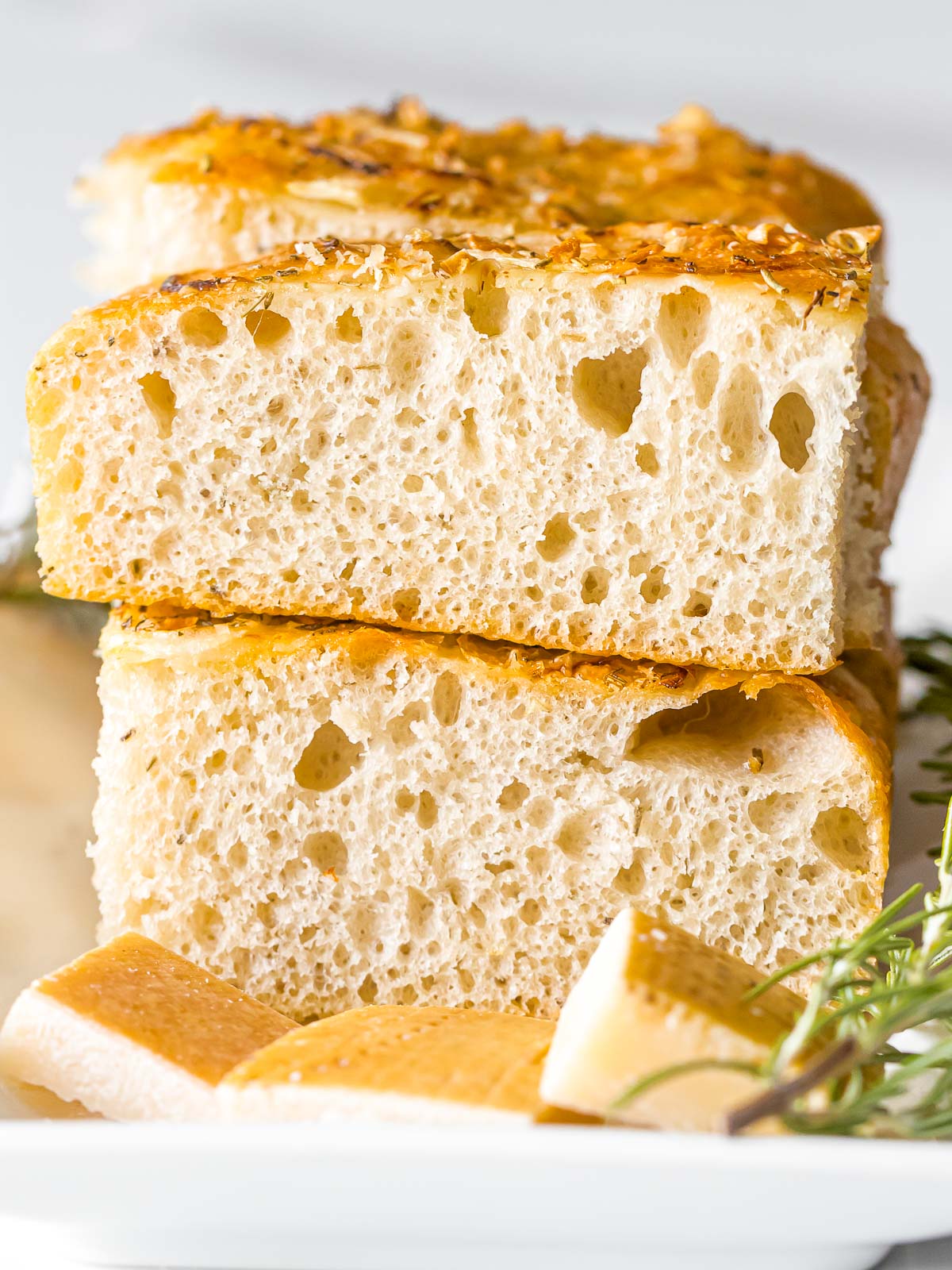
This sourdough focaccia is the best version of focaccia I've ever tasted! It's a tried and true recipe passed down from a professional baker trained in working with wild yeast and fermented dough. This baker also happens to be in my family, who's now retired but passing down her recipes to me one by one. Yes I'm very lucky!
Why you'll love this recipe
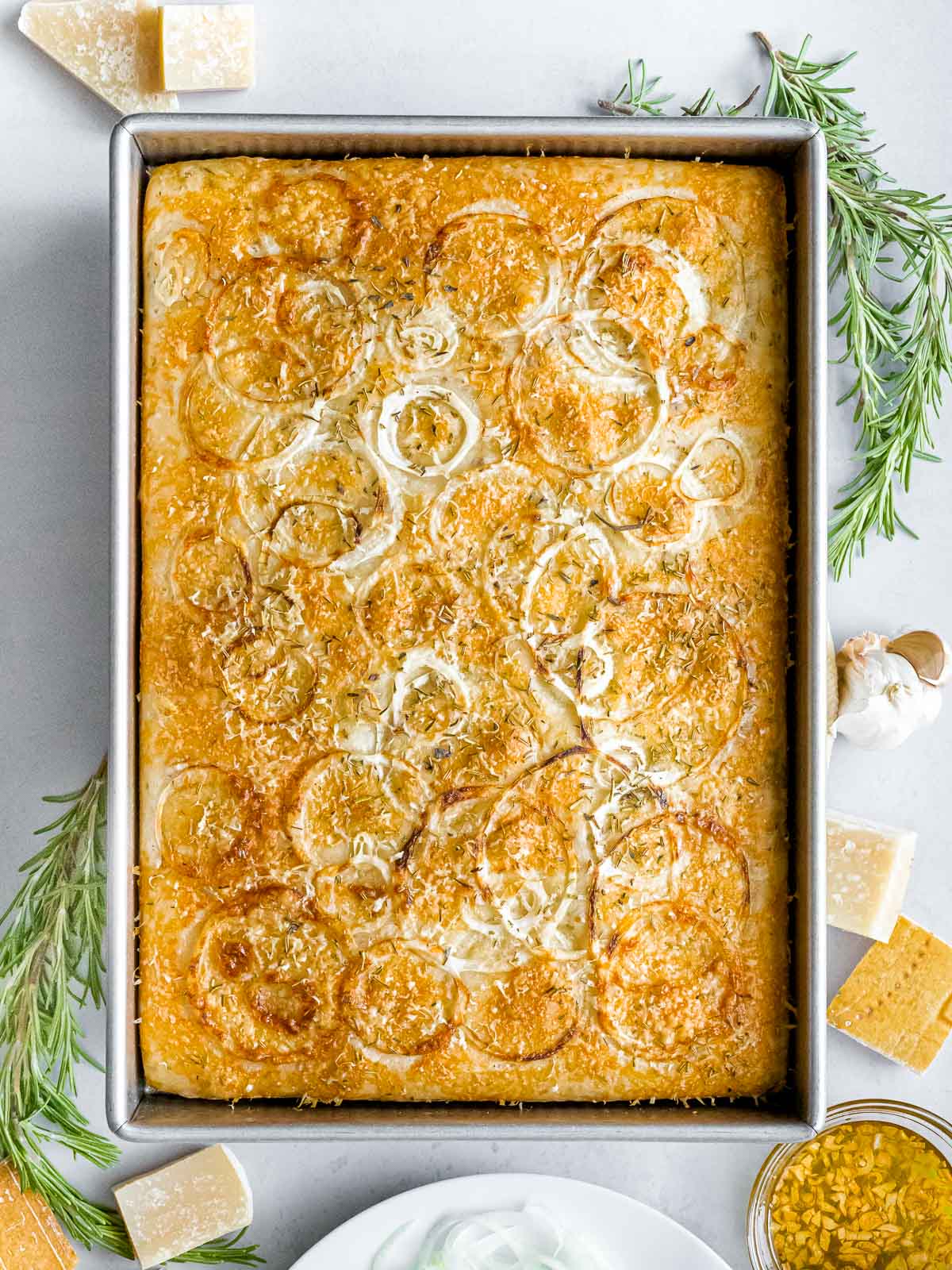
- This sourdough focaccia is extremely soft, fluffy, and moist! It has a delicate crumb with a subtle chewiness that's satisfying to bite through!
- It's flavored with rosemary, garlic oil, and parmesan cheese! The perfect savory snack or appetizer. You can even make sandwiches with this!
- The addition of poolish and sourdough starter give his rosemary focaccia a complex flavor and texture that you won't find with recipes using just store bought yeast! It will definitely be worth your time taking this extra step.
Ingredients you'll need
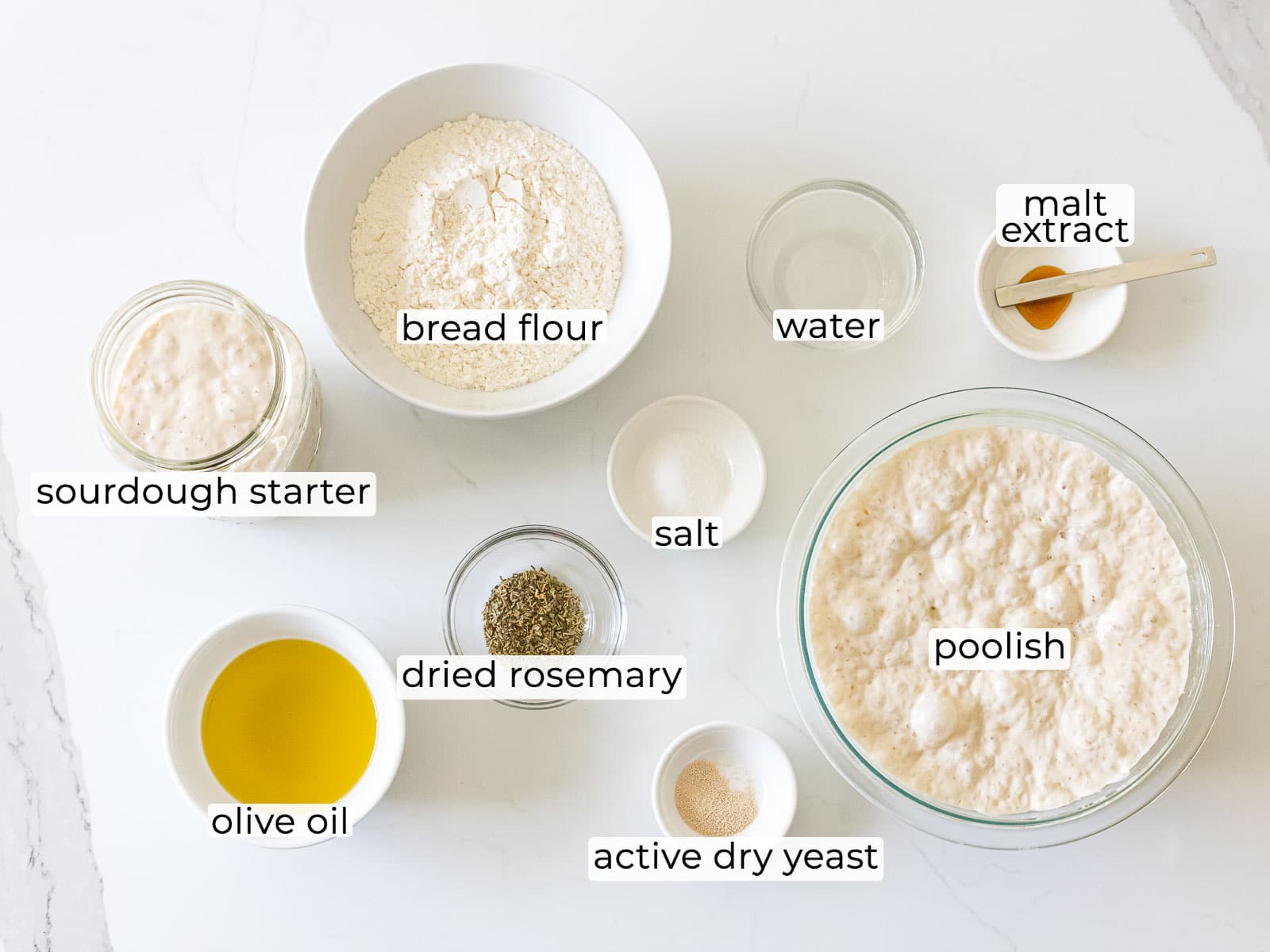
- Sourdough starter - feed your starter the day before and 4 - 6 hours before starting the recipe. You want to use it when it's most active. In my case, I use it when it's two to three times the volume.
- Poolish - this is a type of pre-ferment that adds complex flavor to your focaccia. Make this 12 hours before using.
- Barley malt syrup - a thick, sweet syrup produced from grains that acts as food for the yeast in the dough. Substitute with molasses or honey.
- Olive oil - adds richness and flavor
- Dried rosemary - a wonderful herb to use in sourdough focaccia. You can use any dried herb you want.
Toppings:
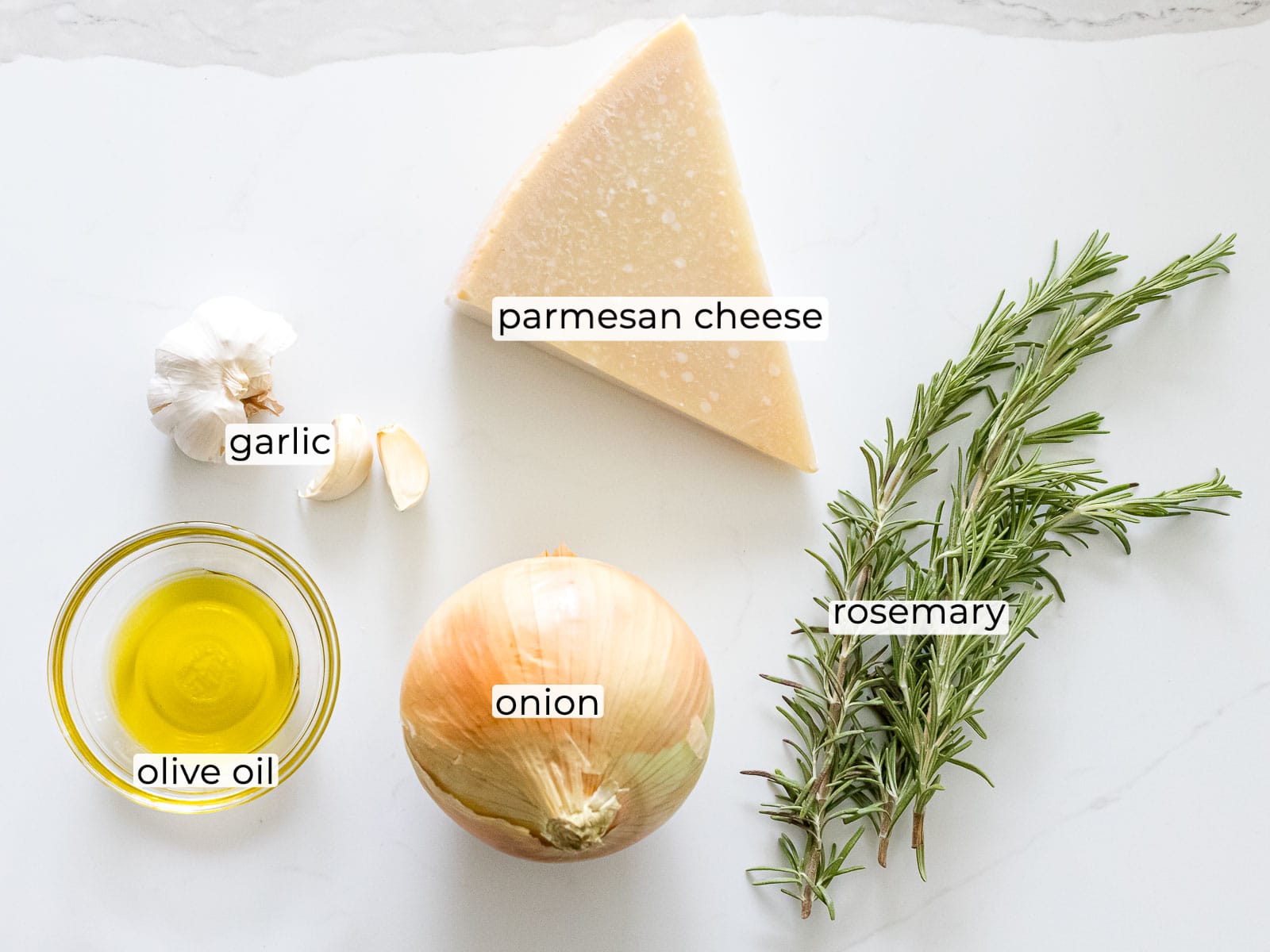
- Rosemary - use fresh or dried rosemary on top
- Parmesan cheese - Use freshly grated parmesan cheese for the best flavor.
- Garlic - lightly simmer with olive oil to make a garlic oil to brush on top of the focaccia once it comes out of the oven.
- Onions - slice thinly and they'll roast on top of the focaccia bread and turn golden brown.
Step by step instructions
- Make sure your starter and poolish is at its most active stage before starting. I make my poolish 12 hours before using it and feed my sourdough starter 4 - 6 hours before use. If you find that your starter and poolish are past their peak rise but aren't ready to start the recipe, you can keep it in the fridge to slow down the fermentation.
- Add all the ingredients except for the olive oil and rosemary to a stand mixer and mix on low with a dough hook until the flour is incorporated.
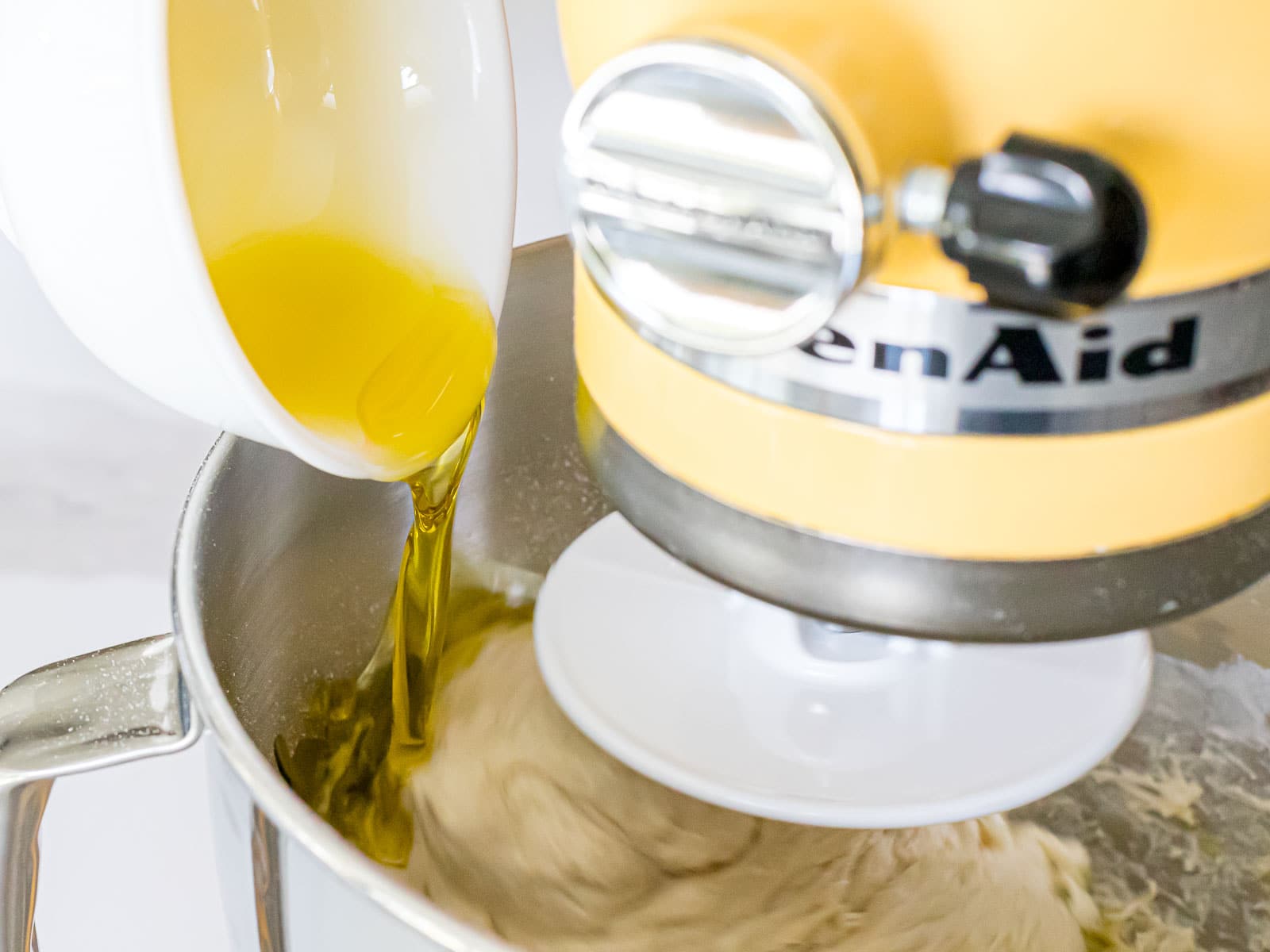
- Add the olive oil and mix on high until you get properly gluten development.
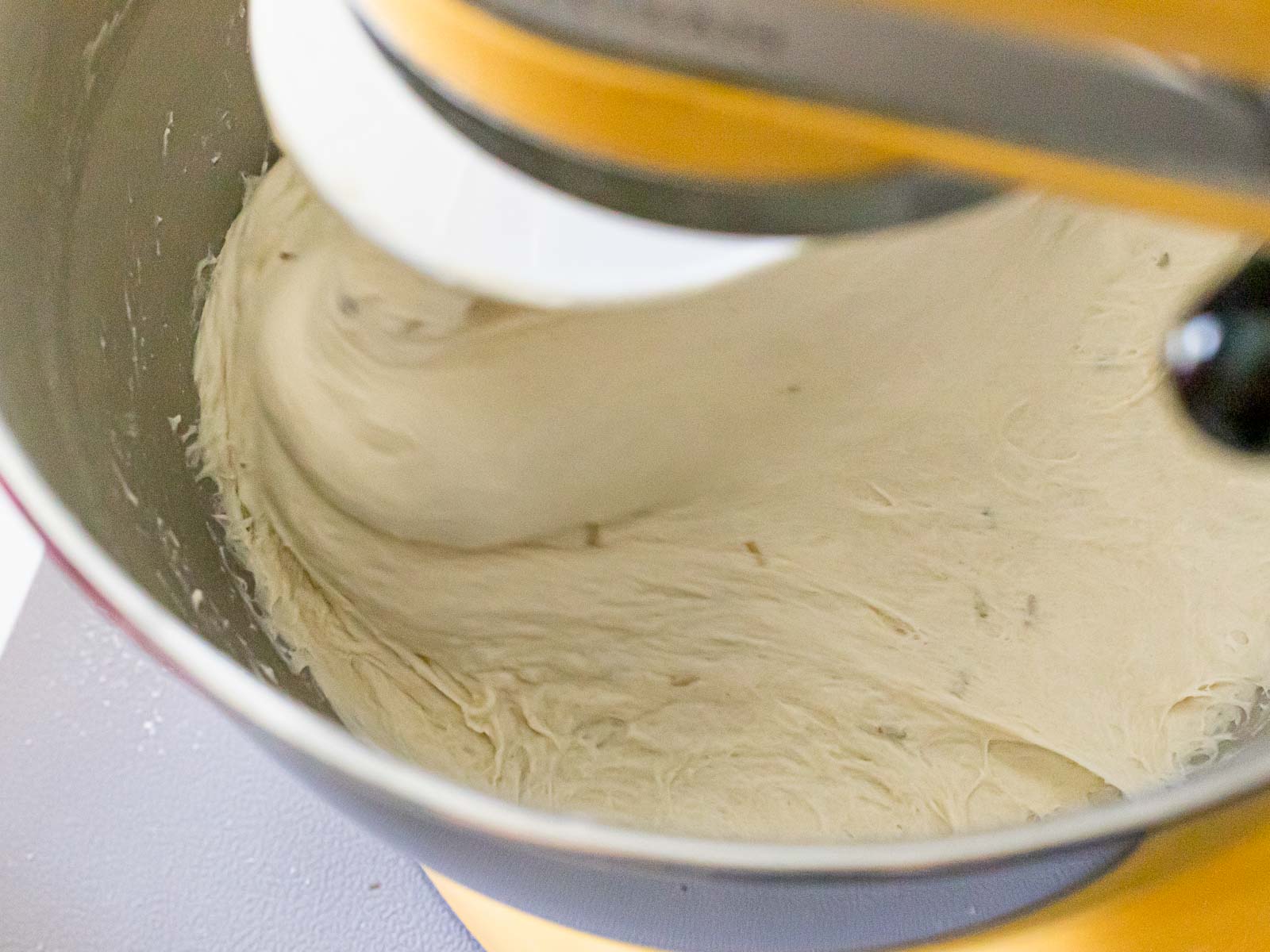
- Test for gluten development once the dough pulls away from the mixing bowl and is not longer sticky. In the photo below, the dough is very wet and easily sticks to my fingers when stretching it between my hands. It's not ready yet.
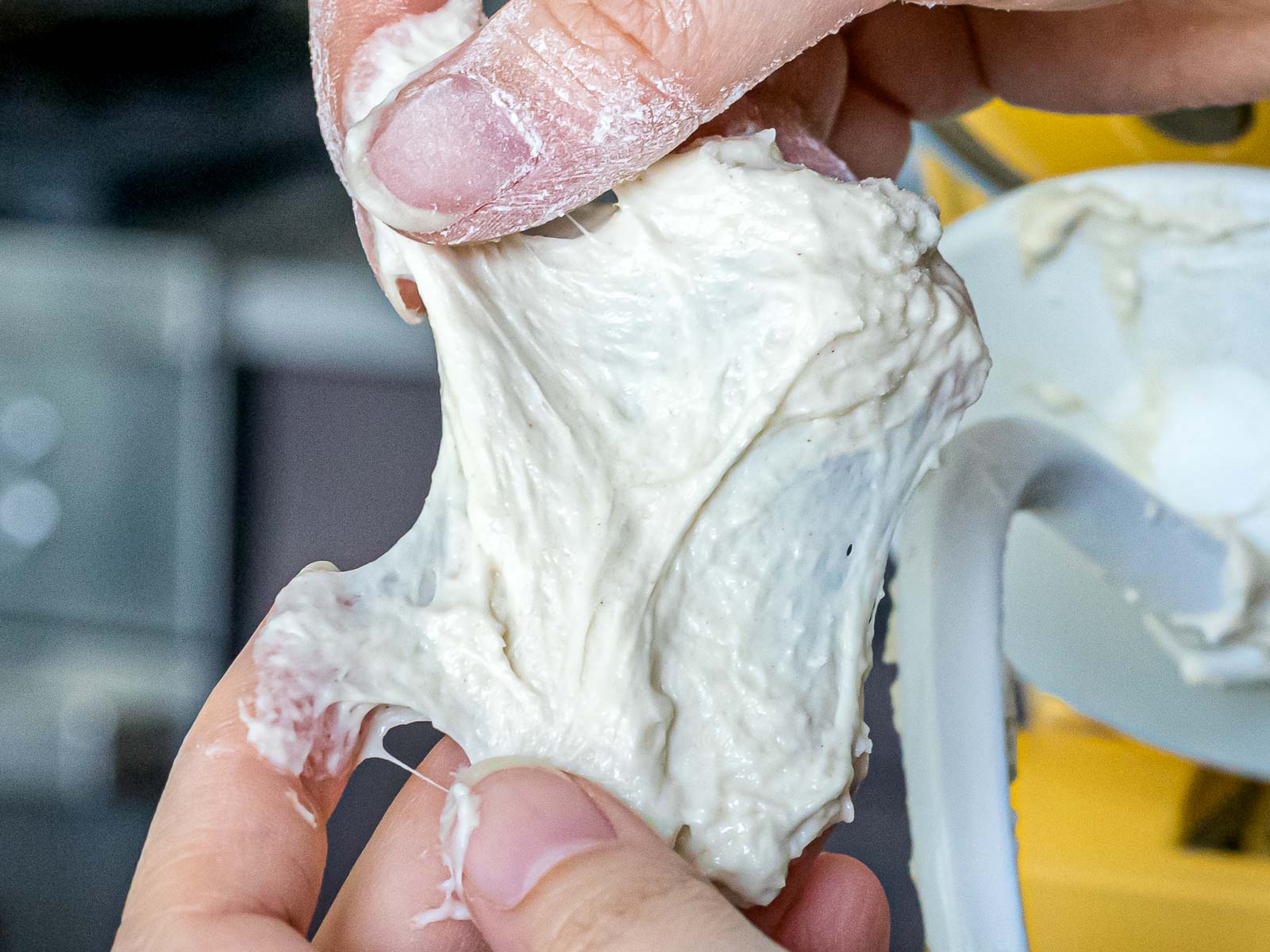
- Below is a photo of the dough after mixing on high for 2 to 3 more minutes. You can see that the dough is smoother, sticks to my hands less, and I'm able to stretch it thinly between my hands until it appear translucent.
This is called the 'windowpane' test. Once it reaches this stage of gluten development, gently mix in the dried rosemary and take it out of the mixer. Next transfer it to a clear, oiled bowl or container.
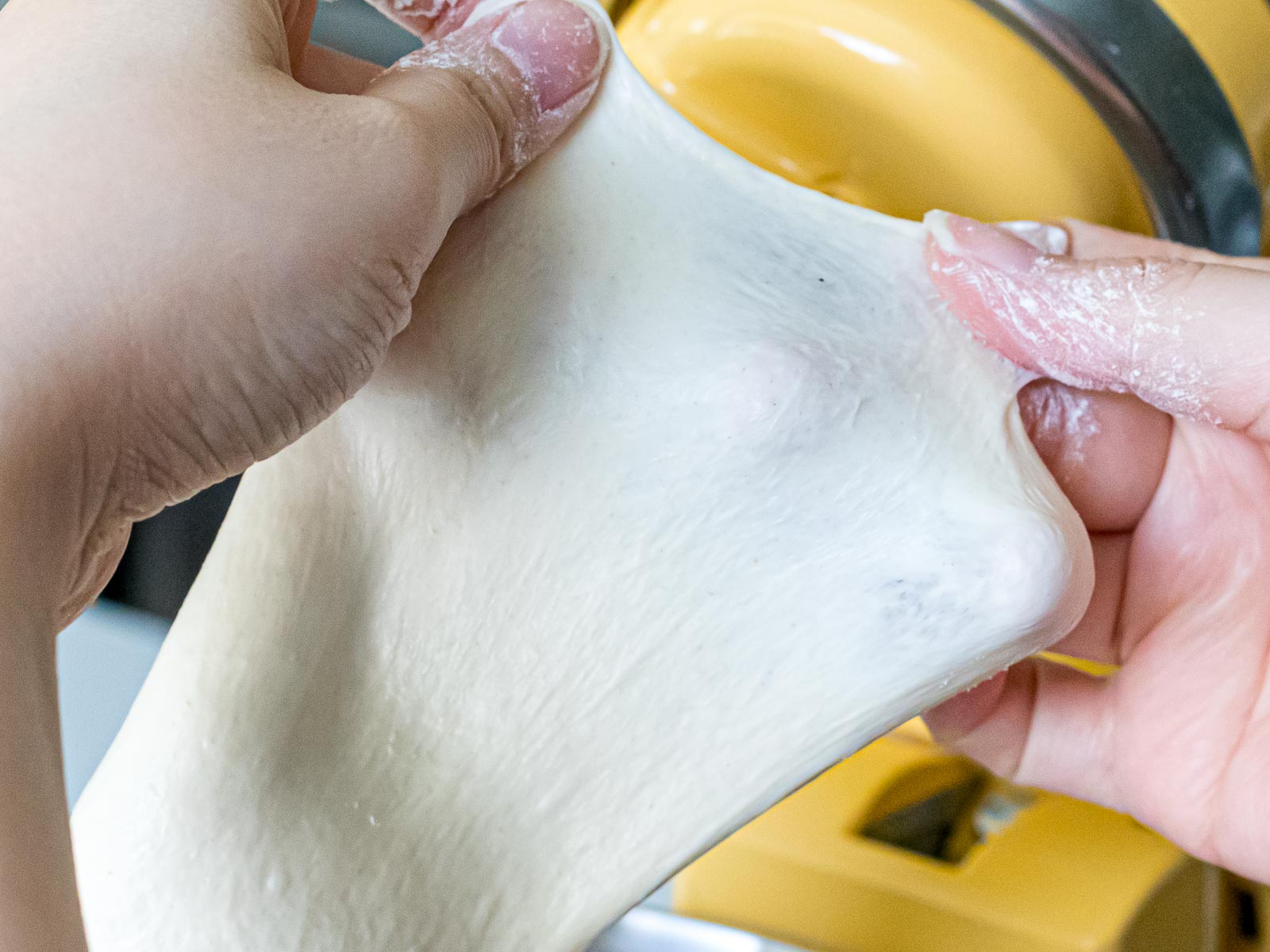
- Oiling the inside of the glass bowl prevents the dough from sticking to it. It's also easy to see how proofed the dough is since you can see the bubbles on the side. Transfer this to a proofer or any warm, humid place and let it proof for 1 hour or until you see small bubbles long the side of the bowl. This is called bulk fermentation, primary fermentation, or first proof.
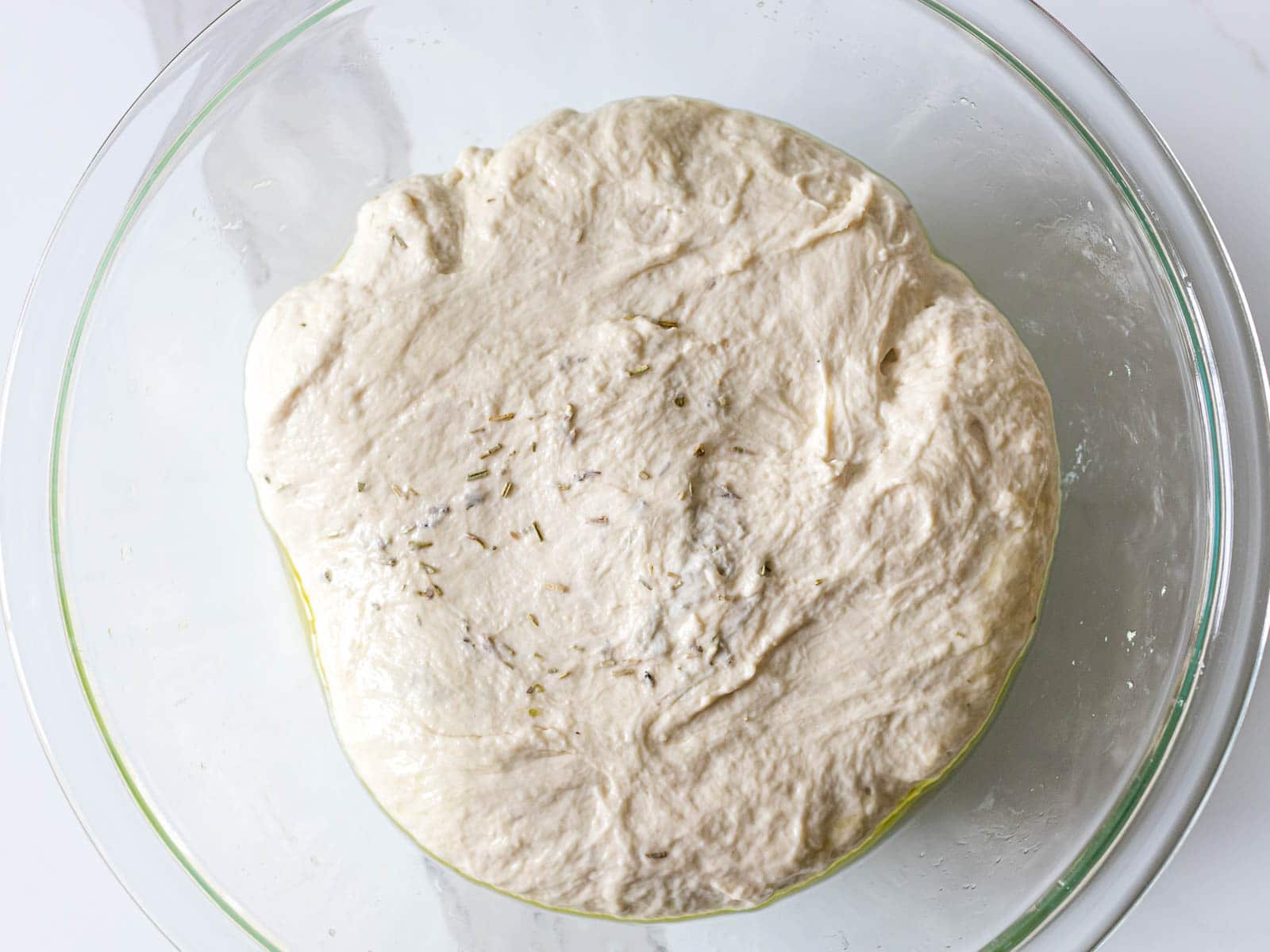
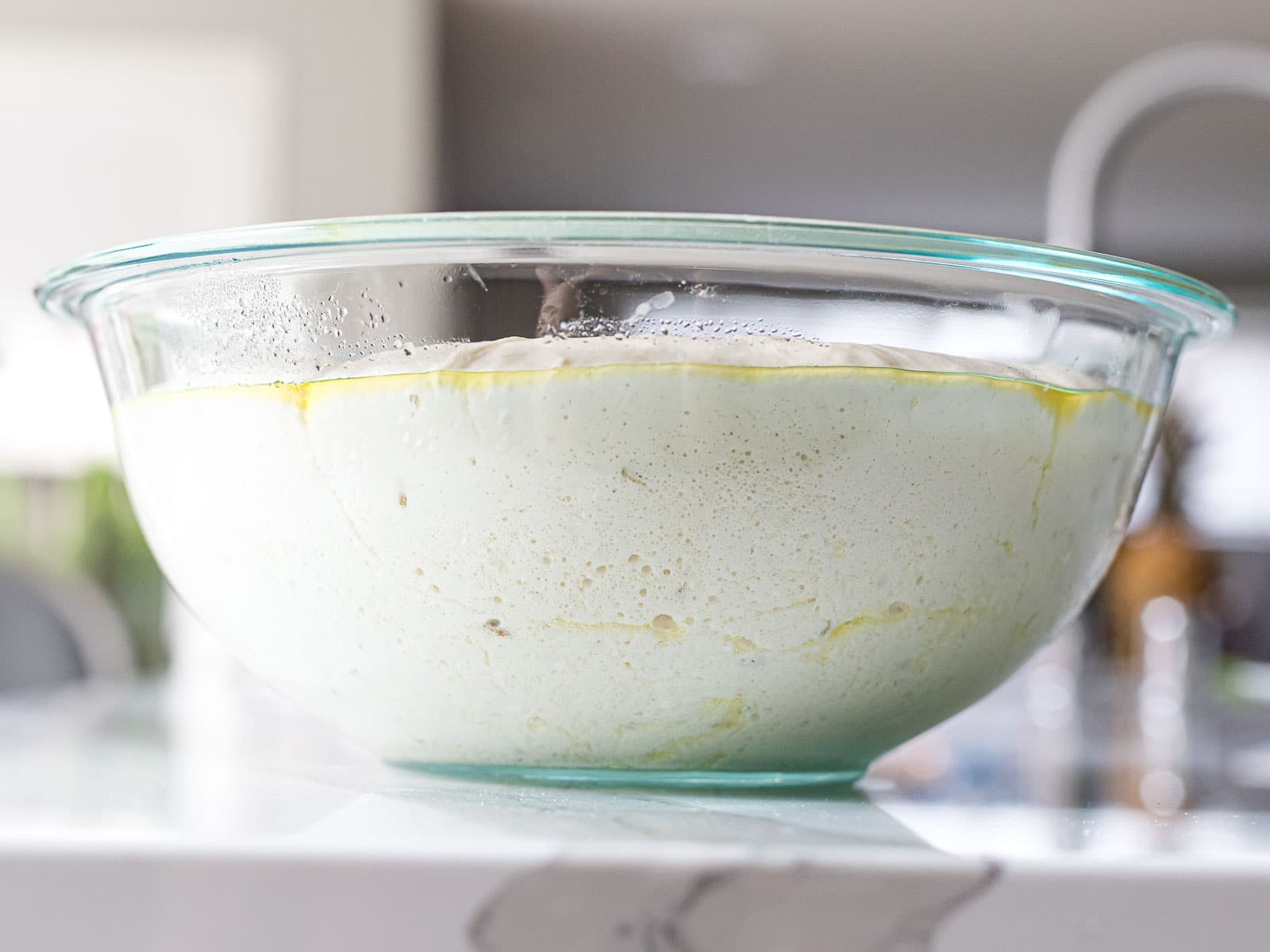
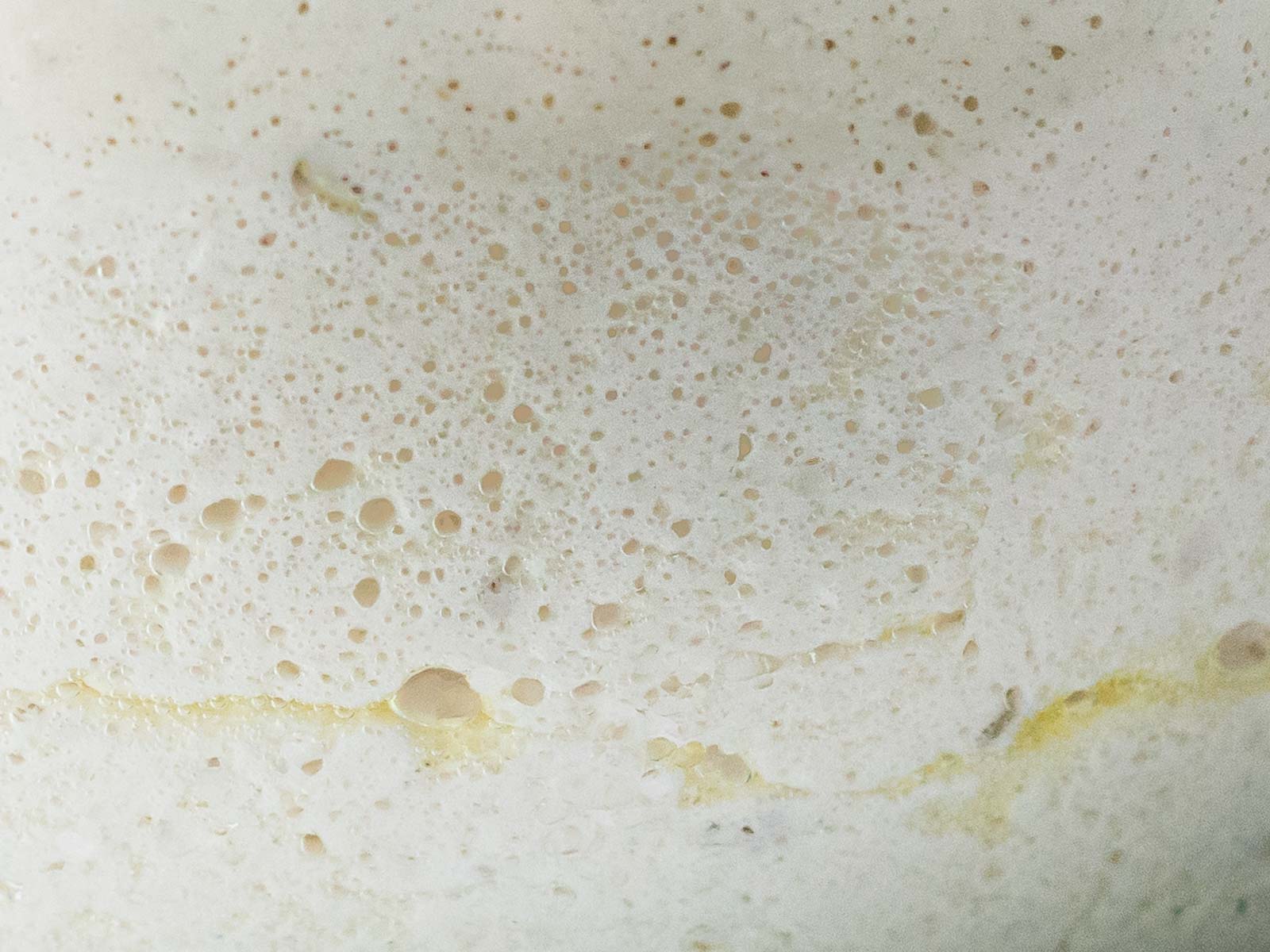
- Grease the inside of the baking pan with olive oil and then transfer the proofed focaccia dough to the baking pan.
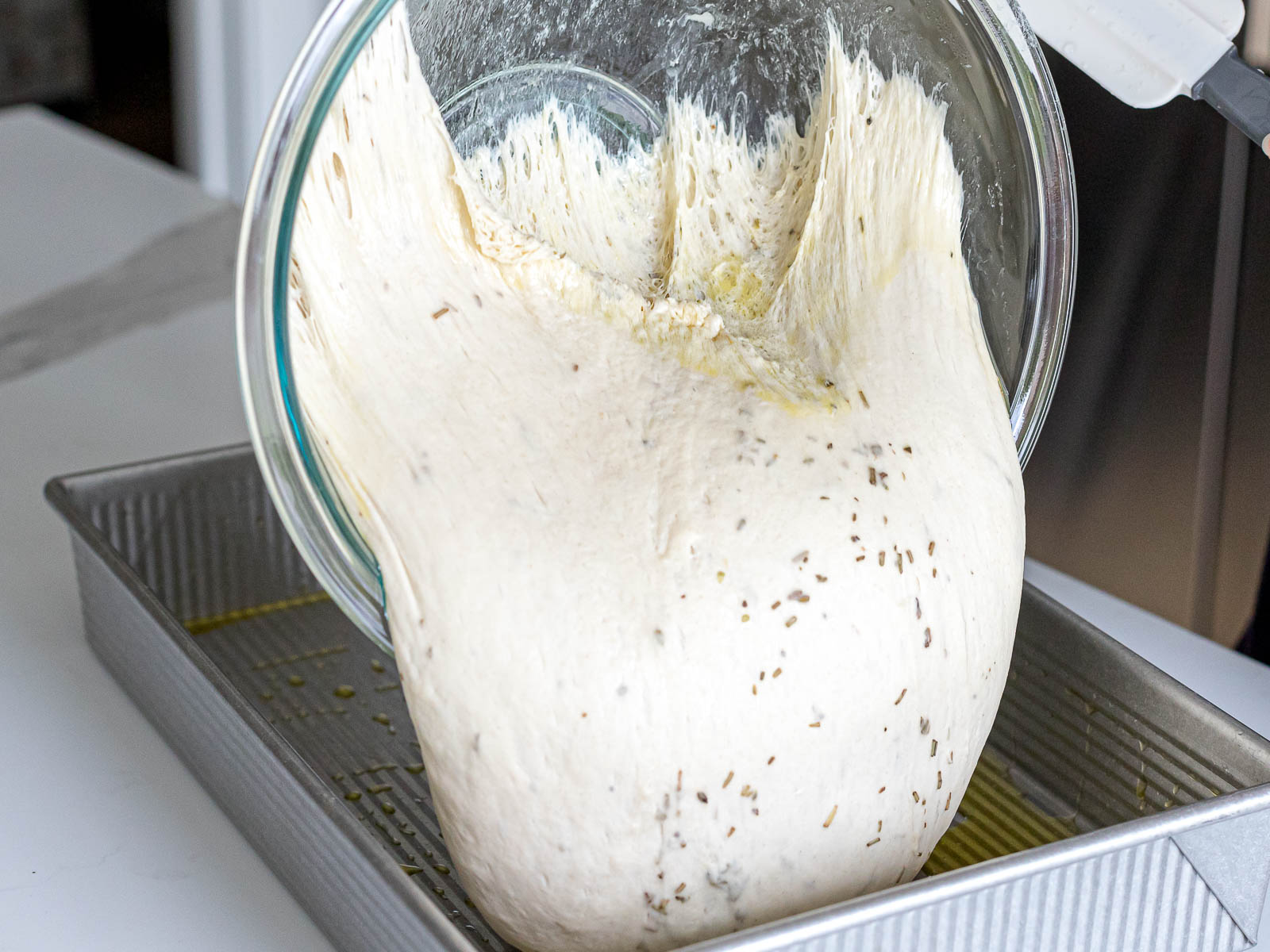
- Spread the dough flat and push it into the corners of the pan. Make sure the dough is an even width for even baking.
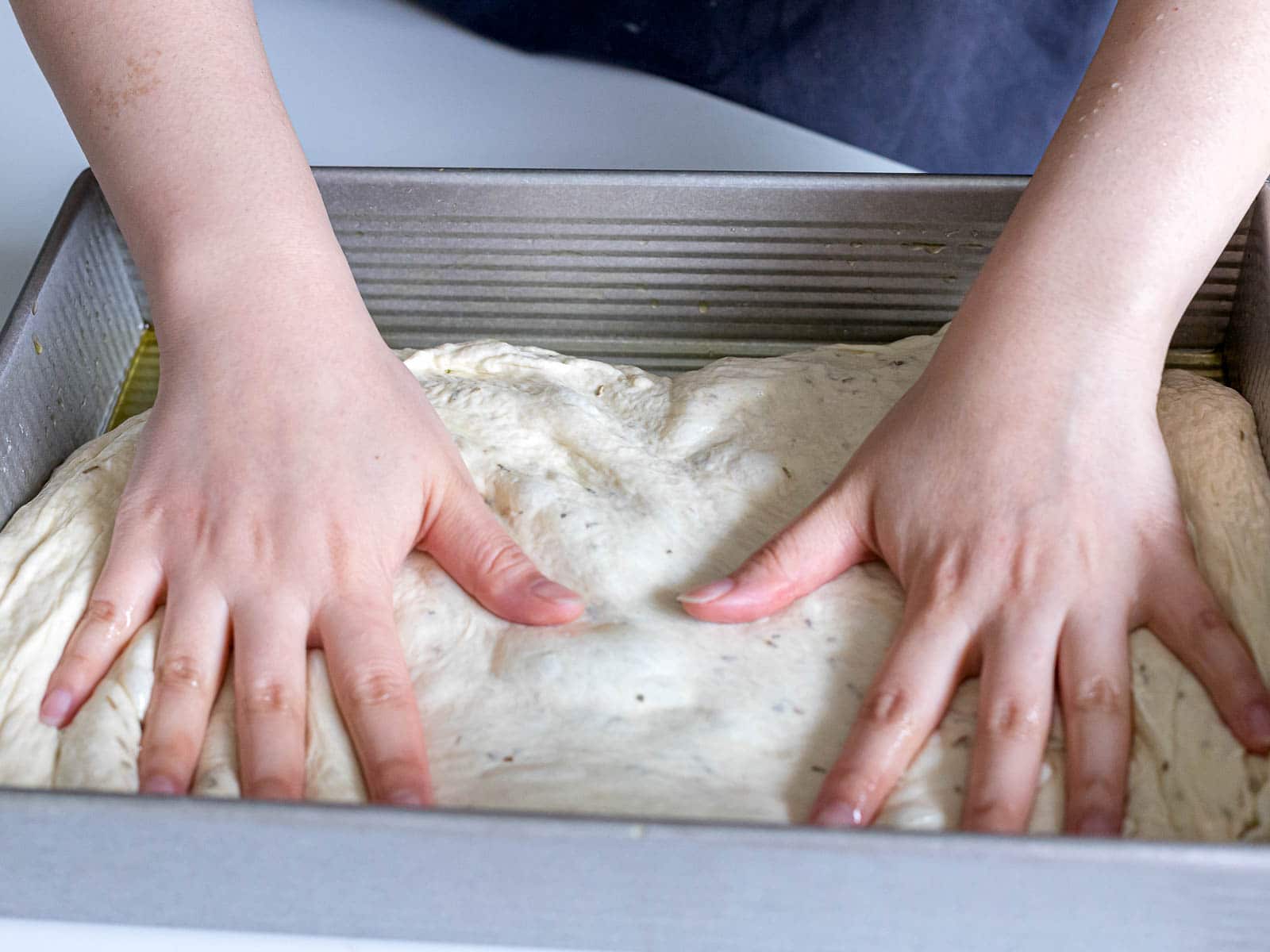
- Let it proof for 30 more minutes or until it almost doubles in size. This step is called proofing or final fermentation.
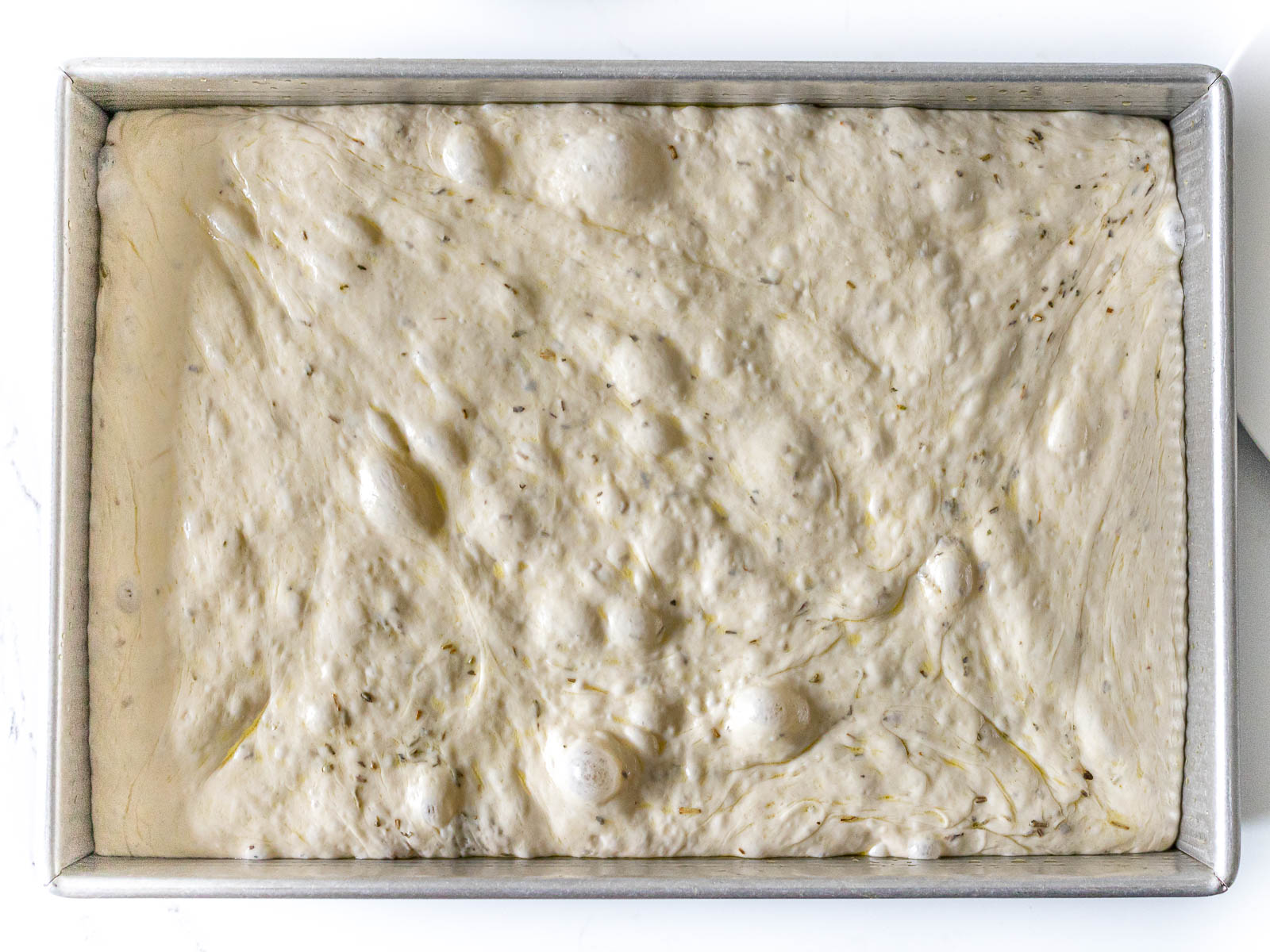
- While the focaccia dough is undergoing its final fermentation, prepare the toppings of rosemary, grated parmesan cheese, and the garlic oil.
- Heat the minced garlic and olive oil in a small saucepan and let it simmer until the garlic turns a light brown. Turn off the heat. This will be brushed on top of the focaccia bread right when it comes out of the oven.
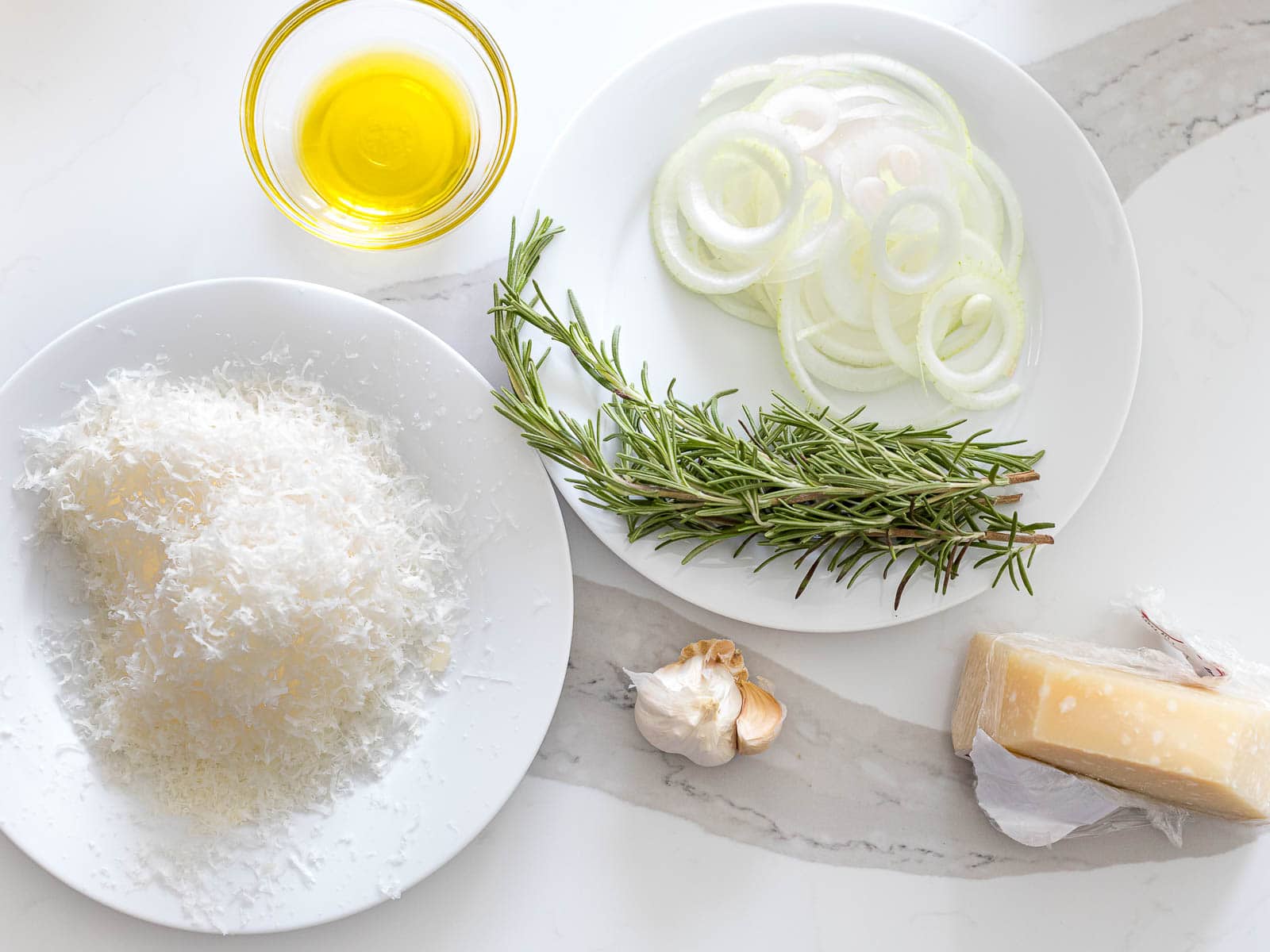
- Gently place the sliced onion, parmesan cheese, and rosemary on top of the focaccia dough and bake it in a 420 degree F preheated oven for 20 minutes.
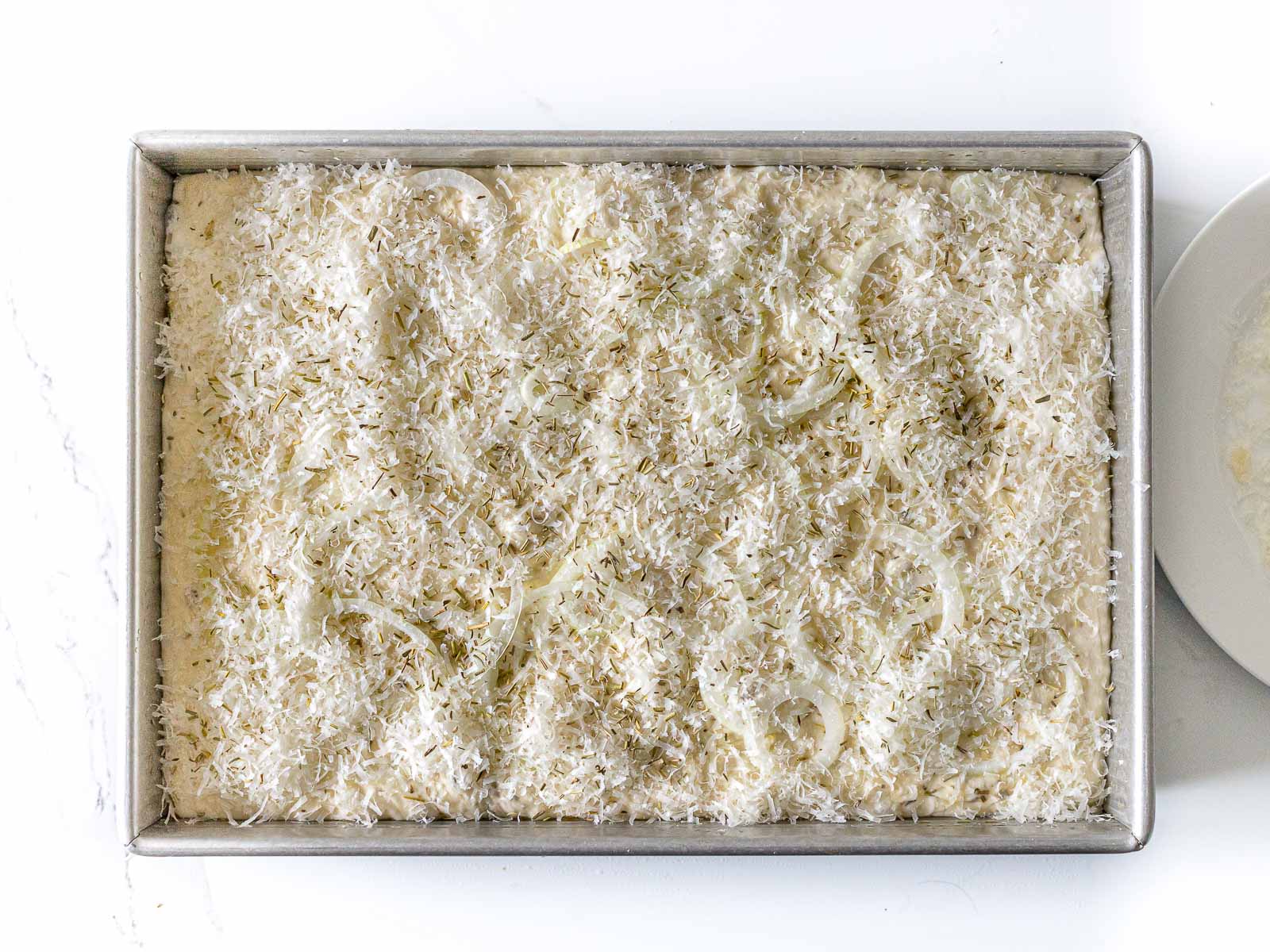
- If you have a convection oven, turn on the fan during the last 5 minutes of baking to get a golden brown crust and further brown the sliced onions and cheese.
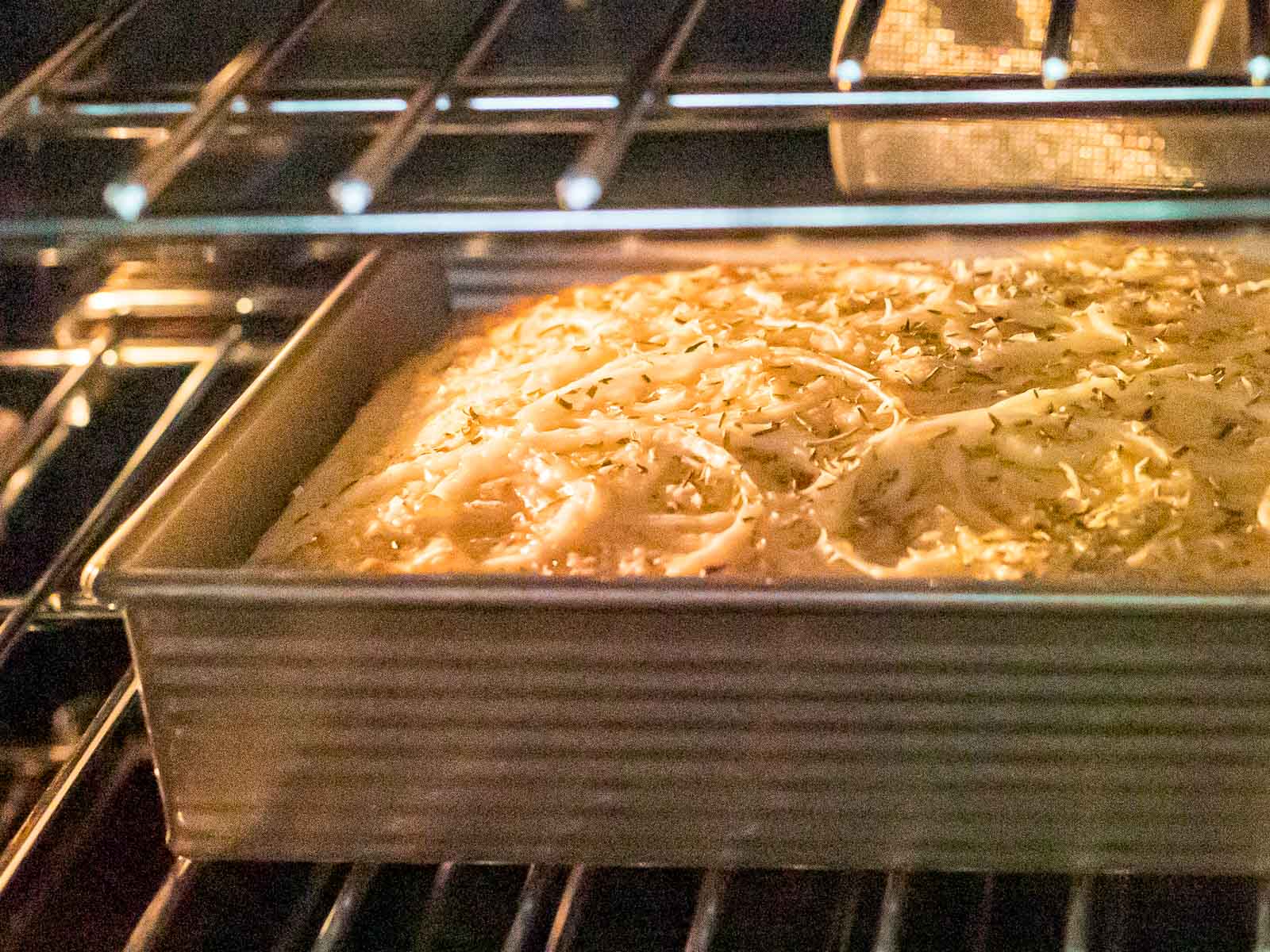
- As soon as the sourdough focaccia comes out of the oven, brush it with the garlic oil we made earlier.
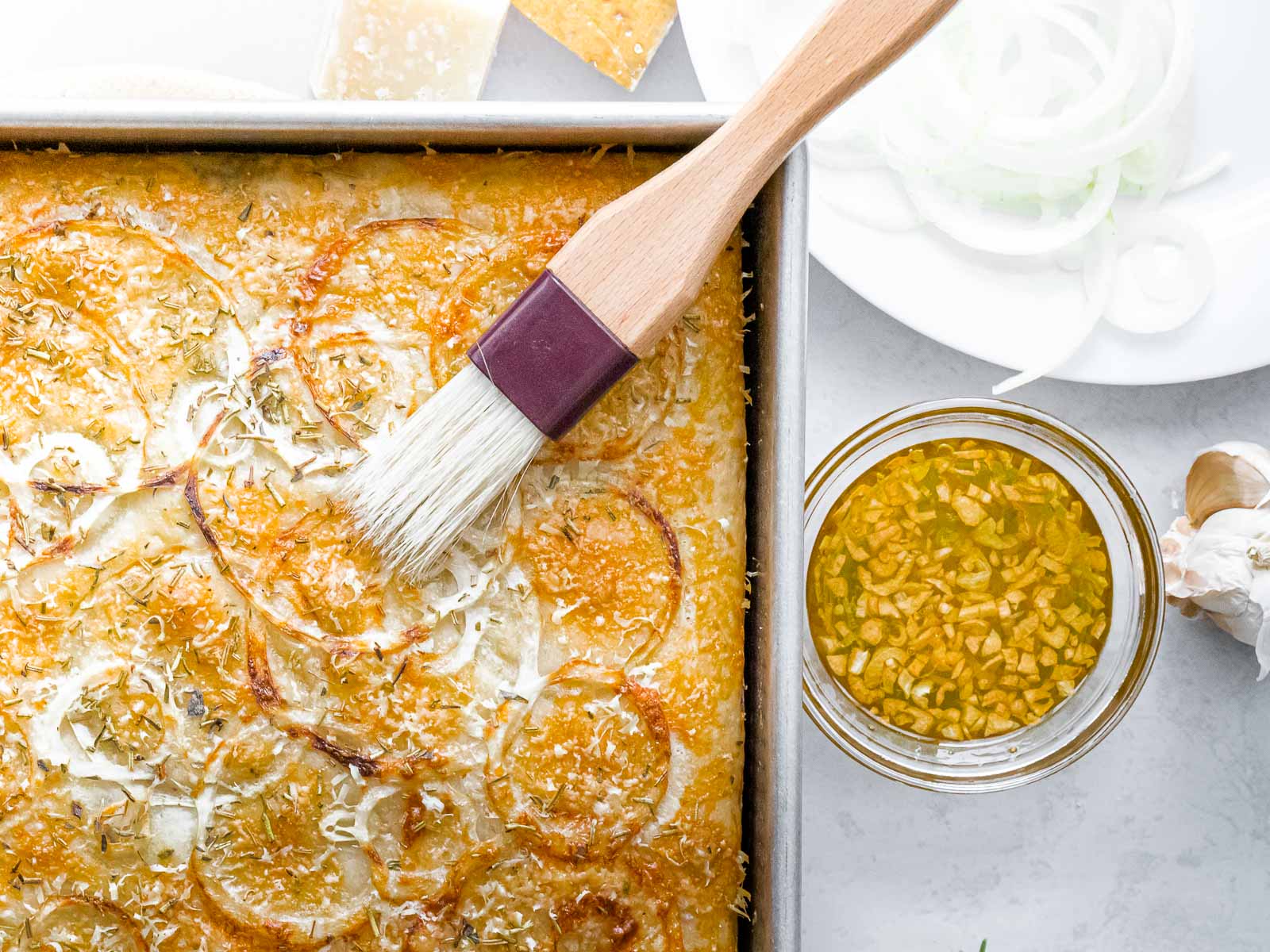
This creates a nice sheen on top of the rosemary focaccia and imparts a wonderful garlic flavor and aroma!

- Transfer over the focaccia bread onto a wire rack to cool which will help prevent steaming in the pan. Slice and serve the most delicious sourdough focaccia with rosemary and garlic oil!
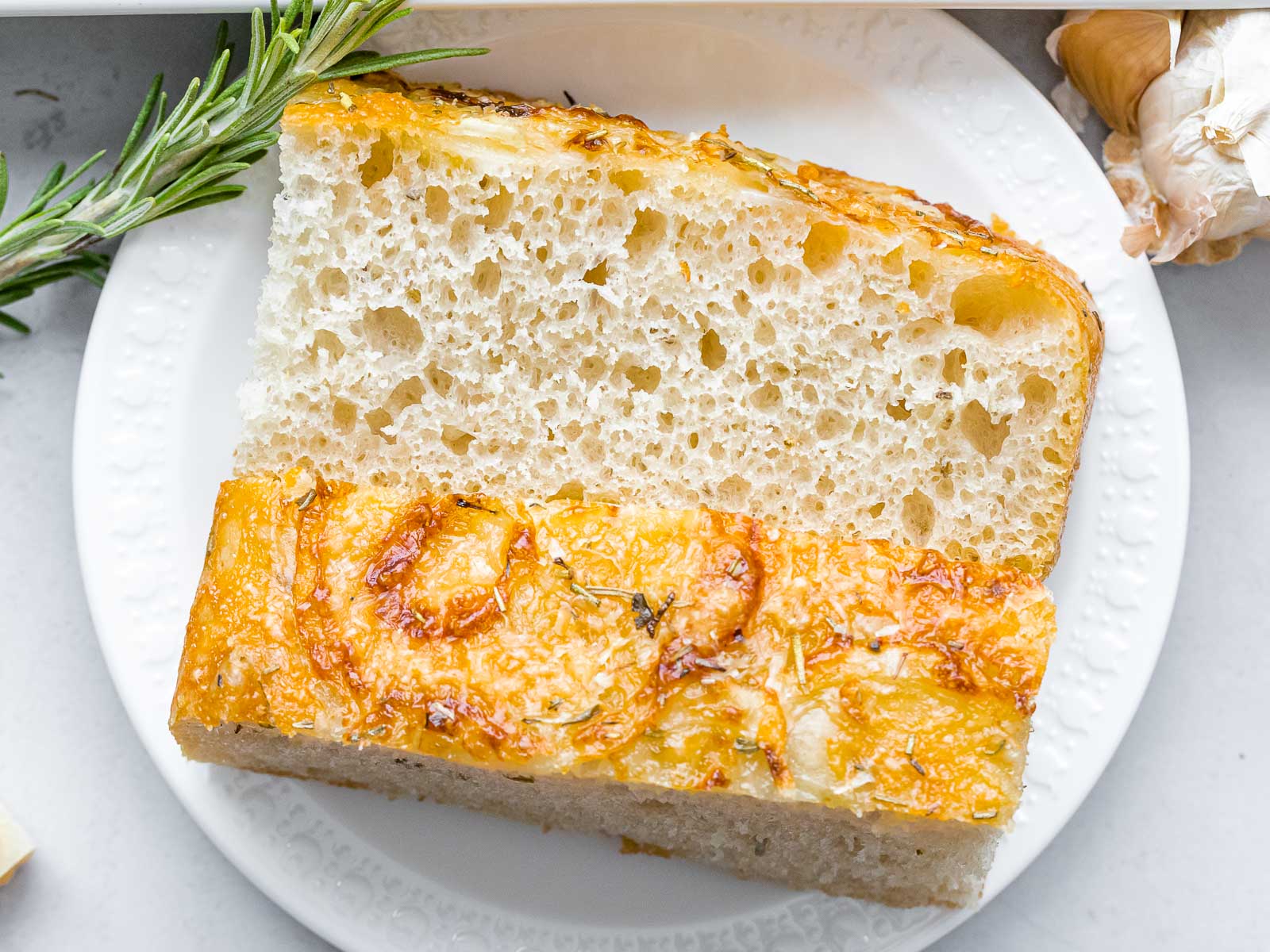
Expert tips and tricks

- Use a good quality olive oil for this recipe
- Make sure your sourdough starter and poolish are at their peak when you use it in the recipe. This ensures that you'll get maximum rise out of your dough.
- Based on my experience with my starter, it peaks when it reaches 2.5 times the volume after feeding. It's best to get familiar with your starter so you know how long it takes but the general rule of thumb is you want it to at least double in volume before using it in any recipe.
Variations and substitutions

- Dried herbs - use any dried herbs you have on hand. Other great options besides rosemary are: oregano, thyme, parlsey, and basil.
- Cheeses - if you don't have parmesan, try asiago, pecorino, or manchego cheese. Adjust the amounts based on the salinity of the cheeses.
- Toppings - instead of sliced onions, try leeks, shallots, chives, or any other vegetables in the allium family. You can also add slices of fresh tomatoes or olives to this focaccia.
Frequently asked questions
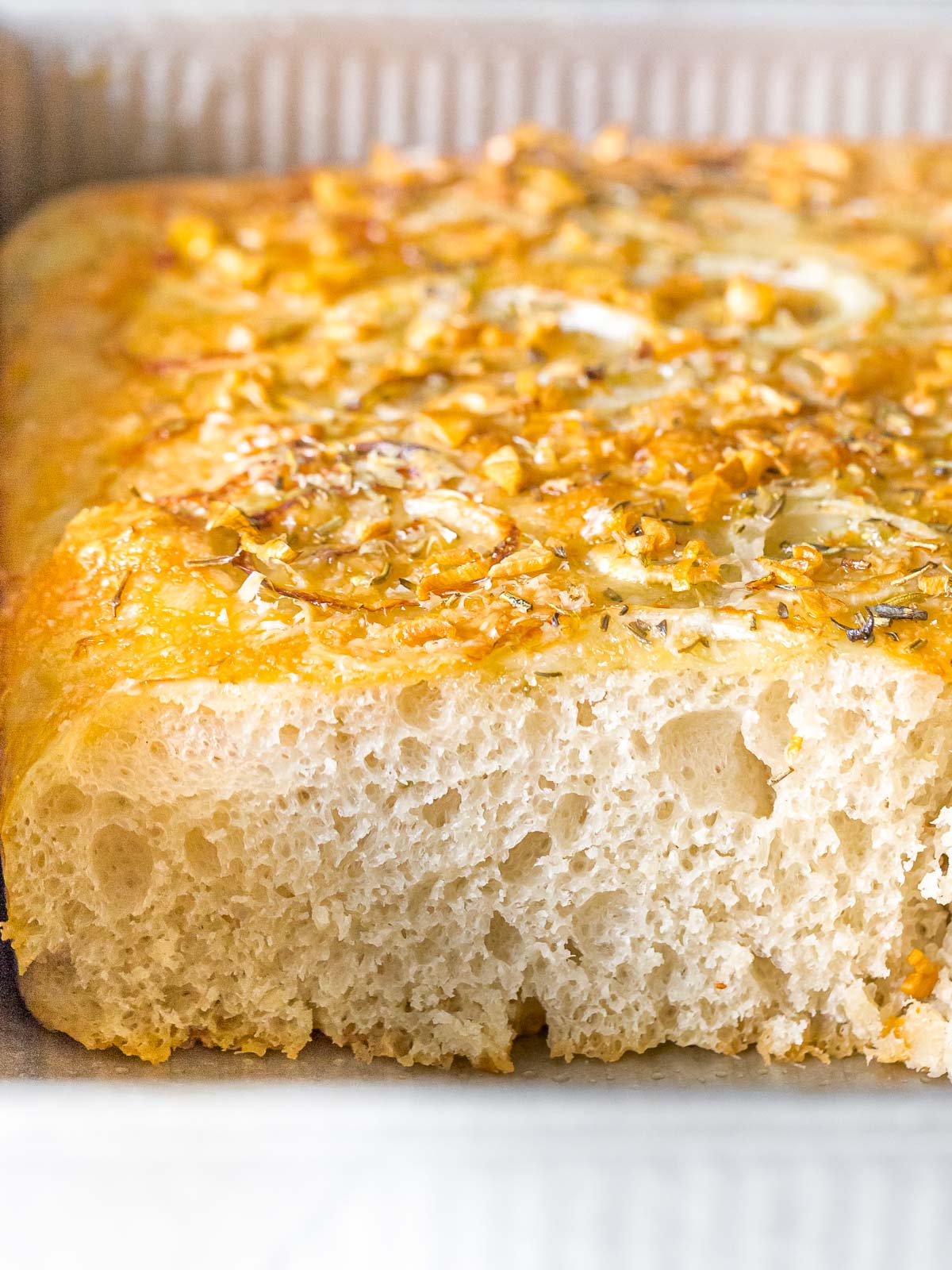
The best way to store leftovers is to pre-slice them, wrap them tightly in plastic wrap, and then store them inside air-tight containers or ziplock bags. This prevents them from getting stale and freezer burn. They taste amazing when toasted in the oven at 350 degrees F. This is my preferred way to store and reheat any type of bread.
Make it into a sandwich. Focaccia makes excellent sandwich bread and goes well with any fillings!
More recipes to try:
- Sourdough Starter 2 Ways – Traditional and No-discard method
- How to Make Yeast Water with Fruit
- Custard Bread Pudding with Vanilla Sauce
- Butter Cookies – Easy 6 Ingredient Recipe!
- Bakery Swiss Roll Cake Recipe
- Easy Lemon Blueberry Bread with Walnuts
Recipe

Sourdough Focaccia with Rosemary and Parmesan
Equipment
☑ Ingredients
Poolish (use when it's most active):
- 300 g water
- 300 g bread flour
- 0.4 g active dry yeast - - or 1g live yeast
Focaccia Dough:
- 200 g bread flour
- 100 g sourdough starter - - use when it's most active
- 60 g olive oil
- 10 g sea salt
- 5 g water
- 3 g barley malt syrup - - substitute with molasses or honey
- 2 g active dry yeast
- 2 g dried rosemary
Toppings:
- ¼ small onion - - sliced thinly
- ⅔ cup freshly grated parmesan cheese
- 3 cloves garlic - - minced
- ¼ cup olive oil
Instructions
Prepare your starter and poolish
- Mix together the poolish ingredients in a large container and let it sit at room temperature for 12 to 14 hours before making the focaccia. It should increase in volume and show bubbles at the surface. Also feed your starter several hours before starting this recipe so that it's at its peak and you have enough to measure out 100g. General rule is to have your starter and poolish double in volume, if not more. You may need to plan ahead so that you can start at your desired time.
- Note: I usually make my poolish 12 hours before using it and feed my starter about 4 - 6 hours before use. This is based on my experience with my starter and the ambient temperature of my kitchen, which hovers around 74 degrees F. You may need to adjust your times based on your ambient temperature and how fast your starter rises. You can speed this up or slow it down by changing the surrounding temperature.
Weigh your ingredients
- Set aside the dried rosemary and olive oil. Add the remaining ingredients for the focaccia dough into a stand mixer including the poolish. Make sure the salt and yeast don't touch in the bowl before starting your stand mixer.
Mixing
- Mix on low with a dough hook until most of the flour is incorporated. Then add in the olive oil and gradually increase the speed to high speed. (Note: Oil and dough won't mix well together unless you're on high speed.)
- Mix on high until you see a smooth, glossy dough with a slight sheen on the surface. The dough should not be sticking to the sides of the bowl anymore and it should be formed into a ball.
- Stop the mixer and check if there's enough gluten development by taking a portion of the dough and stretching it between your hands. The dough is ready when you can stretch the dough thin enough for it to be translucent without tearing. It should still have enough elasticity to spring back. (Note: This is called the windowpane test to test for appropriate gluten development.)
- Next, start the mixer on low and add the dried rosemary. Mix on low until it's well incorporated. Then transfer to a large clear container that's coated with oil. (Note: We want to mix on low because we're trying to avoid tearing the gluten strands and we don't want to develop any more gluten. Mixing on high speed would develop too much gluten at this point and will tear the gluten because of the dried herbs.)
Bulk Fermentation and Proofing (also called Primary and Secondary Fermentation)
- Transfer the dough to the bowl and loosely cover with plastic wrap. Put it in the proofer until you see it almost double in size. If using a clear container, you should see tiny bubbles going all the way up the sides. This took me a little over an hour but your timing may vary according to your temperatures. (See Notes section below for how I proof my dough.)
- Grease a baking pan with olive oil and spread the dough evenly and push it into the corners with oiled hands. This will de-gas the dough and the volume will deflate. Then put it back into your proofer until it's almost double in size. This took about 30 to 40 minutes for me, but it may differ according to your environment. Meanwhile, preheat your oven to 420 degrees F.
- Remove from the proofer and gently place the sliced onions and grated cheese on top.
Bake
- Bake for 20 minutes at 420 degrees F. If you have a convection oven, turn on the fan 5 minutes before taking it out to create a golden brown crust and brown the cheese.
- While the focaccia is baking, heat the garlic and ¼ cup of olive oil in a small sauce pan until the garlic starts to simmer. Turn off the heat. Brush the top of the focaccia bread with the garlic oil right when it comes out of the oven.
- Transfer the focaccia to a wire rack to prevent it from steaming in the pan. Slice into rectangles and serve.
✎ Recipe Notes
- Use an oven: Place the dough on the top rack of your oven and an empty pan on the bottom rack. Pour boiling water halfway up the pan on the bottom rack and keep the oven door closed. This will create enough heat and humidity to proof the dough. You can also leave the oven light on if you need more heat.
- Use an insulated cooler or icebox: Add about 1 inch of hot water to an insulated cooler and place the dough inside on top of a container to keep it away from the hot water. This will create a warm, moist environment similar to a proofer. This is my preferred way to proof bread at home.
Nutrition
*Nutritional information is an estimate, calculated using online tools.





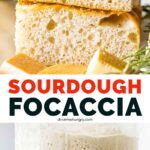
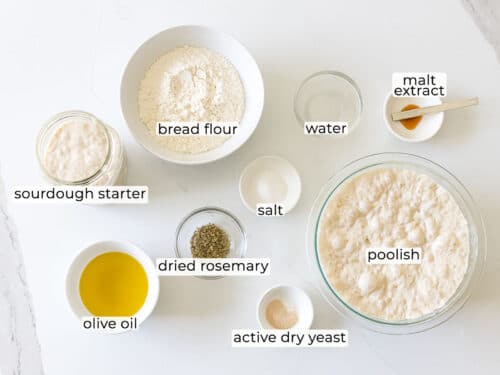
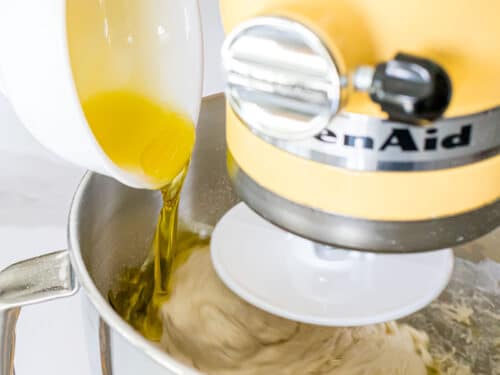
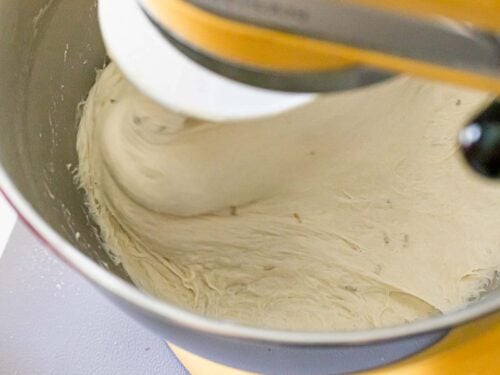
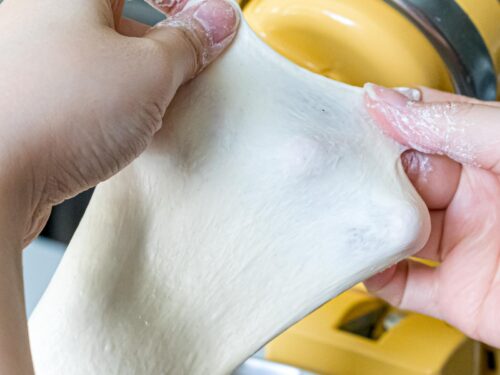
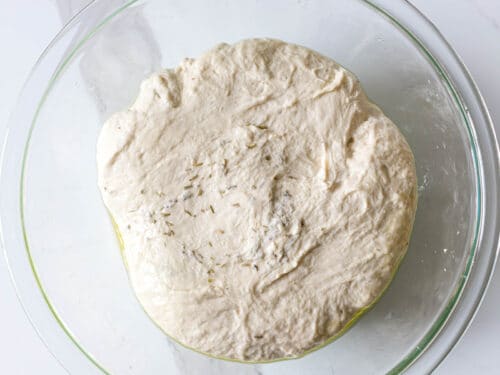
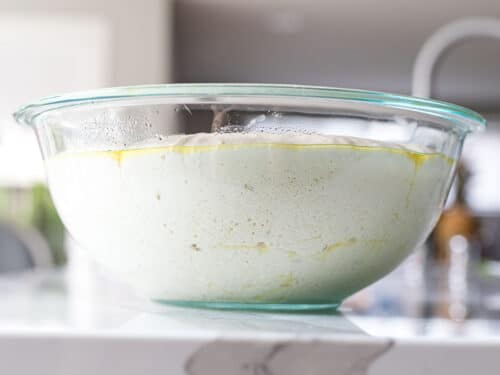
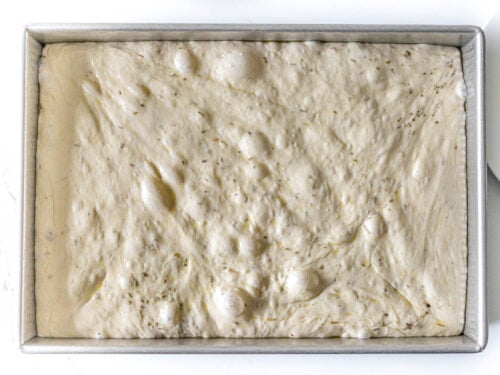
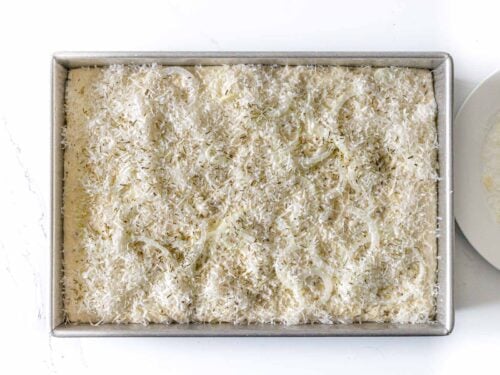
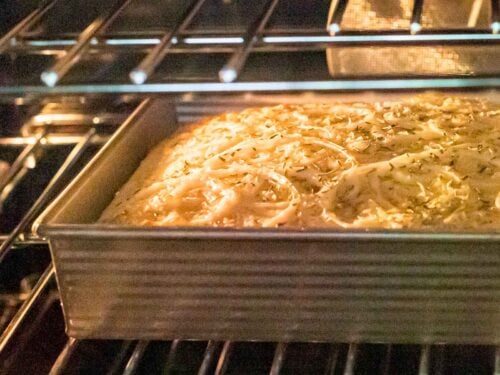
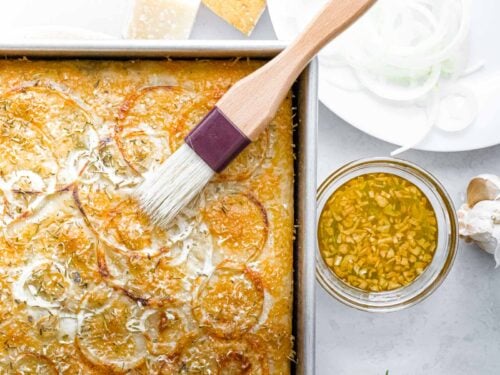
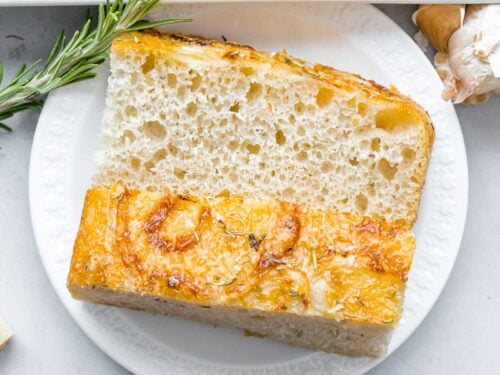
Callie
What a great recipe! This is the best rosemary focaccia recipe I've tried! The poolish really makes a difference and it was pretty easy to follow. Delicious!
Adrianne
Wow this focaccia is so delicious and I love how detailed the steps are! I hadn't heard of poolish before, so I am glad you explained that also. Cheers
Biana
I never made sourdough focaccia, but have a starter going and will definitely be giving this recipe a try! Rosemary, garlic, Parmesan -- love these ingredients together.
Lima Ekram
I love the idea of brushing with garlic oil! This recipe is a keeper! Love it!
cyndy
Thank you for these amazing and detailed instructions. This might be the most delicious looking focaccia bread I've ever seen!
Jessie
This is the second time I have made this, and it will be our go-to recipe for bread for now on. I followed the recipe as is for the first time, but mixed things up a little bit the second time with the toppings. Both were great, and I love the flexibility of the recipe! We roasted some garlic and it was delicious with the bread!
Jamie
Thanks Jessie! So glad you enjoyed this. Great idea adding roasted garlic, it's a very versatile recipe indeed! 🙂
Suzy
Loving how you easily broke down the instructions in order for it to come out just perfect! The best bread ever!
Jamie
Thank you so much Suzy!
Vicky
I've never had sourdough focaccia bread until now but after tasting this, I can't go back! This was so moist and light, definitely better than using commercial yeast. Incredible flavor!
Jamie
Thanks Vicky! I totally agree it's better with sourdough starter!
Nart
Tried this recipe and it was so delicious. Love the combination of rosemary and parmesan!
Jamie
So glad you liked it Nart!
Amanda Marie Boyle
I was just gifted some sourdough starter - can't wait to try this!
Jamie
Hope you enjoy it Amanda! Let me know if you have any questions. 🙂
Veena
This was fresh, moist, and so delicious! Thanks for your detailing to this recipe. There's really nothing like making something homemade. We had it with dinner with a dollop of butter.
Jamie
So glad you enjoyed it Veena!
Julia
This recipe is giving me the courage finally try focaccia bread. Very clear and simple instructions. Thank you for sharing!
Tabitha
I had been looking for a good focaccia for so long, and I came across this one yesterday. It has a few steps to follow, but they're all simple, and they produce the most amazing result. Today, we are enjoyed delicious, light sourdough focaccia. The flavour is incredible (make sure to use a good olive oil as the post suggests) and I love the toppings. Thank you so much. This will be the only focaccia recipe we will use from now on!
Jamie
Thank you so much Tabitha! So glad you enjoyed this sourdough focaccia! It's definitely worth the extra time isn't it? 🙂